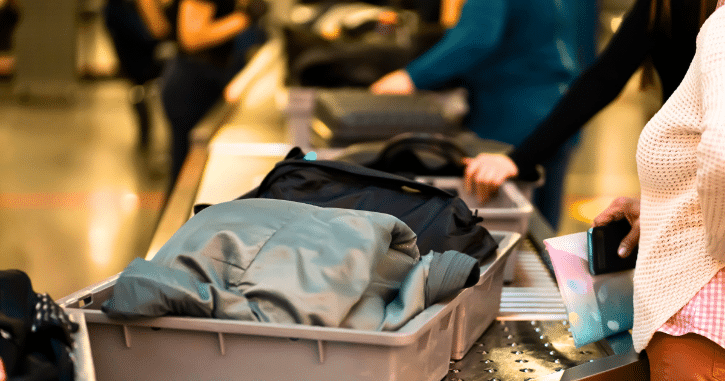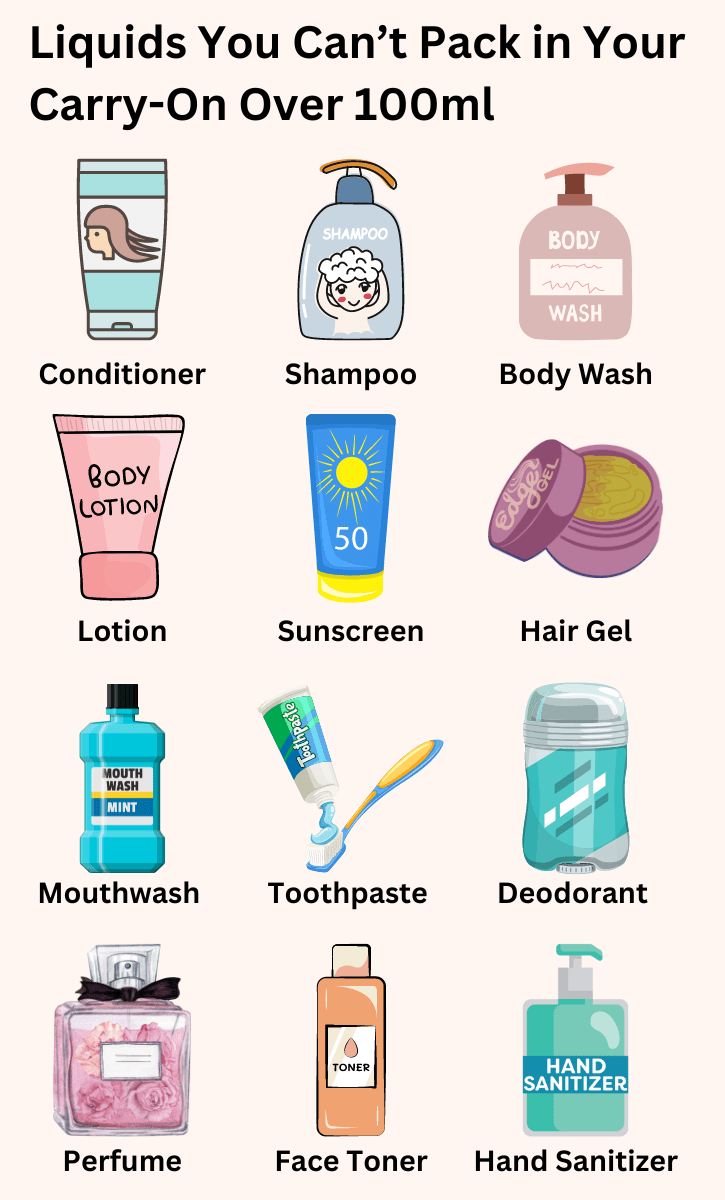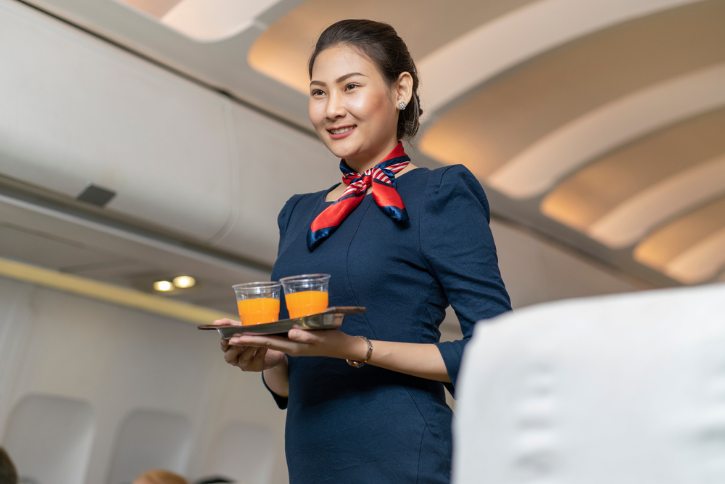
Getting ready for your flight? Hold on a second! Not everything can go in your carry-on bag. From oversized liquids to sharp objects, there are strict rules about what’s banned.
Knowing what not to pack will save you time, stress, and potential trouble at the airport checkpoint.
Want to avoid any packing mishaps? Let’s explore the 10 items that should never find their way into your carry-on luggage! 🙂
1. Liquid Limit Rule

You’ve probably heard about the 3-1-1 rule: each passenger can only bring liquids in containers of 3.4 ounces (100 ml) or less.
These containers must fit into one quart-sized, clear plastic bag.
This applies to toiletries like shampoo and toothpaste, so pack wisely to stay within the limit.

a. Bag Size and Requirements
- The liquid bag cannot exceed a total capacity of 1 litre.
- The bag must be transparent and resealable.
- It should close securely to meet airport security standards.
- Only one bag is allowed per passenger.
- All liquids must fit neatly inside the bag.
b. Presenting Your Liquid Bag at Security
To speed up the screening process, make sure your liquid bag is easily accessible.
You’ll need to present it separately from your carry-on luggage at the security checkpoint. This ensures a smooth and hassle-free inspection.
2. TSA’s Definition of Liquids

The TSA has a broad definition of what counts as a liquid.
Many items that you might not think of fall under this rule, and it’s important to understand which items need to comply with the 3.4-ounce (100 ml) limit.
a. Common Liquids and Gels
The definition includes obvious items like water and beverages.
- Personal care products such as hair gel, shower gel, and lotions
- Sunscreen
- Roll-on deodorants
- Toothpaste
- Shampoos and conditioners
- Liquid soap
- Mouthwash
- Hand sanitizer
- Face creams and serums
- Makeup remover
b. Pressurized Products
Pressurized foams and sprays, such as shaving foam or spray deodorants, are considered liquids as well.
These products must follow the same restrictions and be packed accordingly.
c. Foodstuffs and Miscellaneous
Certain food items like yogurt and liquid-based foods are also classified as liquids.
Even peanut butter, which may not seem like a liquid, is included in the list due to its consistency.
d. Liquid Cosmetics
Cosmetic products like foundation, lip gloss, and mascara also count as liquids.
Be sure to pack these items in your clear, quart-sized bag to avoid any issues at security checkpoints.
3. Food and Drink Restrictions

While you can bring solid foods through security, liquids and gels are subject to the 3-1-1 rule. This includes items like yogurt, applesauce, and thick sauces.
Solid foods like sandwiches, candy, firm chocolate, coffee beans, and dry tea bags or loose tea leaves are perfectly fine to bring along.
If your food is more of a liquid or gel consistency, such as soup or dip, it must follow the 3.4-ounce (100 ml) limit.

a. Baby Food
If you’re traveling with a baby or have special dietary needs, there are some allowances for food and drink.
Baby formula, breast milk, and toddler drinks can exceed the liquid limit but should be declared at the security checkpoint.

b. Empty Reusable Containers
To stay hydrated or save money, you can bring an empty reusable water bottle or coffee mug through security and fill it up once you’ve passed the checkpoint.
Many airports have water refill stations, so you won’t need to purchase drinks inside the terminal.
4. Current Food Packing Requirements

When packing food in your carry-on, it’s important to stay organized.
Solid and liquid food items should be packed separately in clear plastic bags to help security agents quickly see what you’re carrying.
This makes the screening process smoother and helps avoid any unnecessary delays at the checkpoint.
a. Packing for Long-Haul Flights
For longer flights, make sure your food is easy to access and packed in resealable containers.
Opt for light, non-odorous snacks like crackers, nuts, or granola bars to avoid any discomfort for fellow passengers.
Bringing simple, pre-packaged items can also save time during the flight and prevent messes.
b. Avoiding Spills and Leaks
To prevent spills or crushed items, always pack your food in leak-proof containers.
If you’re carrying pre-prepared snacks or meals, tightly seal them to avoid any mess inside your carry-on bag.
A well-organized and spill-free bag helps speed up security checks.
c. Country-Specific Food Restrictions
Before traveling internationally, check the destination country’s customs rules on food items.
Some countries have strict biosecurity laws and may restrict the import of fresh food, meat, dairy, or plant-based products.
Knowing these regulations ahead of time can help avoid confiscations at your destination.
5. Portable Chargers with a Capacity Over 100Wh

Portable chargers (power banks) are handy but must follow strict airline rules.
You can only carry them in your hand luggage, and each must have a capacity of 100Wh or less.
This applies to devices like laptops, phones, and cameras.
You can bring up to 20 spare batteries, but the lithium content cannot exceed 2 grams.
a. Batteries in Carry-On Only
Spare or loose batteries, like those in power banks, must always be in your carry-on.
For larger batteries (100-160Wh), such as those for medical devices, you can bring up to two with airline approval. These cannot go in checked baggage.
b. Electronic Devices with Lithium Batteries
Devices like phones, laptops, and medical equipment using lithium batteries must also stay in your carry-on.
Lithium metal batteries can’t have more than 2 grams of lithium, and lithium-ion batteries should be 100Wh or less. You can carry up to 15 personal devices.
c. E-Cigarettes and Vape Devices
E-cigarettes must be in your carry-on or with you, not in checked luggage. You can’t charge them on the plane.
Keep in mind that some countries, like Hong Kong, Singapore, India, and Taiwan, ban e-cigarettes, so check before you travel.

6. Souvenirs as Liquids

When buying liquid souvenirs like perfumes, snow globes, alcohol, oils, sauces, or lotions, remember they must follow the 3.4-ounce (100 ml) limit for carry-ons.
Always check the size before you buy to make sure it fits the liquid rule.
a. Shopping Tips for Liquid Souvenirs
If your souvenirs are larger than the limit, plan to pack them in checked luggage.
Another option is to ship them directly from the store to avoid airport restrictions.
b. Duty-Free Purchases
The safest way to buy liquid souvenirs is to purchase them at the last airport before your final destination.
This way, you don’t have to worry about connecting flights or other airport rules. It makes the process much easier and stress-free.
c. Packaging Tips for Checked Luggage
If you pack liquid souvenirs in your checked luggage, wrap them in bubble wrap or plastic bags to prevent spills and damage.
Proper packing helps ensure your souvenirs arrive home safely.
7. Sharp Objects and Tools

a. Prohibited Sharp Objects
Sharp objects like scissors, knives, and tools are generally not allowed in carry-on luggage.
This includes items like multi-tools, box cutters, and pocket knives, which can be considered dangerous.
Even certain types of nail clippers or tweezers with sharp points may be restricted.

b. Pack Smart for Security
To avoid delays or confiscation, it’s better to pack sharp objects and tools in your checked luggage.
Even if you have a small pocket knife or sharp tool, it’s not worth the risk of it being confiscated at security.
8. Prohibited Weapon-like Items

a. Replica and Toy Weapons
Items that resemble weapons, such as replica guns, toy weapons, or even plastic swords, are banned from carry-on luggage.
Even though they aren’t real, they can still cause confusion and alarm at security checkpoints.
b. Self-Defense Equipment
Items like brass knuckles, martial arts gear (nunchucks, throwing stars), or pepper spray are also prohibited.
These items are seen as potential threats and should be left at home or packed in checked luggage if allowed.
c. Heavy and Sharp Accessories
Certain accessories like belts with heavy buckles, spiked bracelets, or other sharp jewelry could raise concerns and may not be allowed in your carry-on.
It’s best to leave anything that could be viewed as a weapon behind.
d. Pack with Caution
If you’re unsure whether an item could be mistaken for a weapon, it’s always safer to pack it in your checked luggage or leave it at home.
Avoid carrying anything that may cause security delays or confiscation.
9. Sporting Equipment and Self-Defense Items

a. Prohibited Sporting Equipment
Large sporting equipment like baseball bats, golf clubs, lacrosse sticks, and hockey sticks are not allowed in carry-on luggage because they can be used as blunt weapons.
If you’re traveling with this gear, it’s best to pack them in your checked luggage.
b. Smaller Sporting Items
Smaller items like roller skates or skateboards may be allowed in carry-on luggage depending on the airline.
However, it’s important to check the airline’s specific rules and consider packing these items in checked luggage to avoid any issues at security.

10. Flammable Items

a. Prohibited Flammable Items
Flammable items like lighter fluid, gasoline, fireworks, and camping stove fuel are generally not allowed in either carry-on or checked luggage due to their fire risk.
These items are considered hazardous and cannot be packed in your luggage.
Even smaller items such as aerosol cans, matches, and fuel canisters are typically banned from both carry-on and checked bags.
b. Allowed with Restrictions
Certain flammable items like disposable lighters and hair sprays under 3.4 ounces (100 ml) are permitted in carry-ons, but they must comply with the liquid rule.
Make sure these items are placed in your quart-sized liquid bag.

Extra Tip 1: Exceptions to the Liquid Limit
Certain items, such as medications, baby formula, breast milk, and toddler drinks, are allowed in your carry-on without having to adhere to the standard liquid size restrictions.
These items do not need to be packed within a quart-sized bag.
However, you should inform the TSA officers at the checkpoint about these items for a smooth inspection process.
Extra Tip 2: 10 Free Items You Didn’t Know You Can Get on Flights

Did you know airlines offer more than just a seat and a snack? From cozy blankets to special treats like cup noodles, there are plenty of freebies available—if you know to ask!
While some of these perks may vary by airline, it’s always worth a try.
These 10 free items can make your flight more comfortable and save you some cash.
I hope the information below helps, so you won’t miss out on any in-flight extras!
Item 1: Cup Noodles

Did you know that on some airlines, you can satisfy your noodle craving mid-flight? Just ask a flight attendant for cup noodles.
They’ll provide hot water too, turning your journey into a cozy, slurp-worthy experience.
It’s like having a warm hug in a cup, thousands of feet in the air!
Item 2: Snacks

Most airlines offer a variety of free snacks.
From pretzels and peanuts to cookies and crackers, there’s something to keep your taste buds happy.
Don’t be shy – you can often ask for extras if you’re still feeling peckish.
Item 3: Additional Meals

Feeling extra hungry? On long-haul flights, you can often ask for additional servings of meals or snacks.
Flight attendants are usually happy to oblige if there’s extra food available.
Item 4: Refilling Water Bottles

Stay hydrated without the plastic waste!
Bring your empty reusable water bottle through security and ask the flight attendants to fill it up for you.
They’re usually more than happy to help, ensuring you stay refreshed throughout your journey.
Item 5: Complimentary Drinks

Quench your thirst for free! Most airlines offer a selection of complimentary non-alcoholic beverages.
From sodas and juices to tea, you can sip your way through the flight without spending a dime.
Stay refreshed without opening your wallet!
Item 6: Special Drink Requests

Most airlines offer free coffee and hot chocolate. If you want a warm drink during your flight, just ask a flight attendant.
They can provide you with a cup of coffee if you need some energy, or a sweet hot chocolate for comfort.
These drinks can make your journey more enjoyable, especially on longer flights.
Item 7: Alcohol

Many international flights offer complimentary alcoholic beverages with meals.
You might find options like beer or spirits available at no extra cost.
It’s a chance to relax and enjoy a drink while traveling.
Remember to drink responsibly and check with your airline, as policies can vary between carriers.
Item 8: Activity Packets for Kids

Traveling with little ones? Ask for children’s activity packets.
Many airlines offer coloring books, crayons, and small toys to keep kids entertained.
It’s like having a surprise goodie bag to combat boredom and make the flight fun for young travelers.
Item 9: Blankets and Pillows

Need some extra comfort during your flight? Most airlines provide blankets and pillows free of charge.
Just ask a flight attendant, and you can make your seat cozier for the journey. It’s a great way to relax, especially on longer flights.
You might even catch some better sleep with these comfort items.
Item 10: Eye Masks

Need some shut-eye? Many airlines provide free eye masks on long flights.
Block out the cabin light and drift off to dreamland more easily.
It’s like having your own personal darkness switch, helping you arrive at your destination well-rested.

